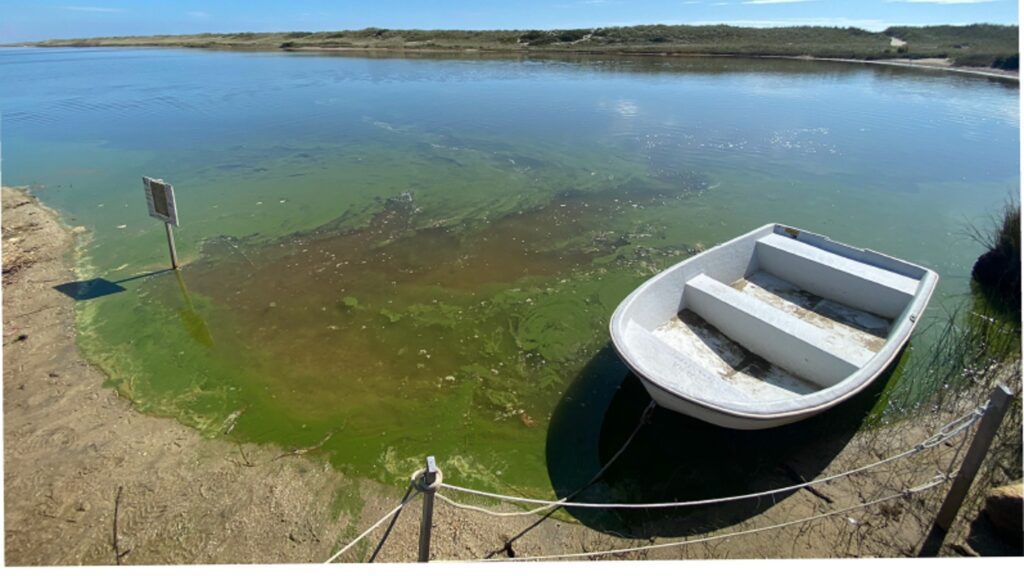Blue-green algae:
Get answers to your questions about cyanobacteria:
Is it safe to go in the water?

Photo at 1pm, by Richard DeWitt.
Conditions: sunny, calm, very slight breeze out of the southwest
Note: With a change in the weather along with wind direction and speed these conditions may look completely different.
By now, many of you have heard about the recent cyanobacterial sampling conducted by the Martha’s Vineyard Commission and reported in the yesterday’s Gazette article. As a scientific organization, Great Pond Foundation values the role of science in decision-making and respects the huge responsibility held by scientists to provide context and critical evaluation when presenting novel data (new discoveries). The health of Island ponds, and those who use them, are also central to our work, but it is too early to determine the magnitude of this issue without further information.
In keeping with the Great Pond Foundation’s mission, we are taking the preliminary results seriously and contacting a team of experts from different fields for context and clarification. We have a lot of questions about the findings and their potential implications. However, grounded in our belief in science, we believe that an evidence-based response to those questions is prudent. We are working with a multi-disciplinary team of experts to collect more data/information, and we will keep you abreast of our findings. For now, please refer to the attached “Cyanobacteria and Public Water Systems MassDEP Guidance” and know that we will be providing you with updates in the near future.
Scientists regard novel discoveries with a child-like enthusiasm and joy, but they also have the tools to temper their excitement with an understanding of the distinction between preliminary data and conclusive evidence. Science without context, replication, and a professional level of skepticism (peer-review) can be dangerous. Currently, our scientific staff has more questions than answers, so we would like to clarify what is known and what questions have yet to be answered. We also want to respond the numerous emails we have received concerning the safety of our beloved Island ponds.
Novel Data Indicate:
- Cyanobacteria (a.k.a. blue-green algae), were detected (via light microscopy) or indicated (via fluorescence) in most of the 11 Island pond samples that were analyzed by scientists at the UNH Center for Freshwater Biology
- Some ponds had the surface-accumulating blue-green algae as was visible in Chilmark Pond this season, and some ponds show indications via fluorometry that there are likely pico (very small) cyanobacteria
- Cyanotoxins, or toxins produced by cyanobacteria were detected in the samples, including microcystins and BMAA (β-Methylamino- l-alanine)
The type of cyanobacteria that accumulates at the surface of a body of water and forms a toxic blue-green scum was not detected in EGP by the recent analysis, nor was a bloom observed, as it was in other MV ponds such as Chilmark Pond. Unfortunately, during the Chilmark Pond cyanobacterial bloom this season, someone did report adverse symptoms after exposure to those waters as reported in the MVTimes article. When there is an active blue-green algae bloom humans and pets should stay out of the affected body of water. Cyanobacteria, in large abundance, or when blooming, are known to produce toxin in quantitIes that are harmful to humans (via dermal contact) and often deadly to pets (via consumption). If you or your pet have been exposed to an active cyanobacterial bloom, please contact your physician or veterinarian immediately.
Both the type and the abundance (concentration; cells/mL) of the cyanobacteria matter when it comes to determining health risks to pets, humans, and ecosystems. Every pond has cyanobacteria (they are normal members of an ecosystem), and some types produce harmful toxins when they bloom, and many do not.
The most well-known type of cyanobacteria (the kind that forms a blue-green scum on the surface and kills dogs) was not found in Edgartown Great Pond. It was however found in other MV ponds. The light spectrum or fluorescence measurements conducted by the UNH lab on samples from EGP indicate that there may be pico (or very small) cyanobacteria, a type that cannot be seen easily with a light microscope. These very small cyanobacteria are distributed throughout the water column and are not found at the surface. The UNH lab also quantified the presumptive toxin BMAA, and it was detected in higher than ever seen levels, in brackish Island ponds. Some suggest a correlation between ALS and BMAA, but causation has not been proven, and more recent science suggests that this connection is not real. If you want to take a deep dive into the scientific debate, read this article that supports the correlation https://www.ncbi.nlm.nih.gov/pmc/articles/PMC1869250/ and this one that refutes it: https://www.ncbi.nlm.nih.gov/pmc/articles/PMC6503681/ .
Public Health & Safety Questions:
- When it is it safe to go in the water?
- Is consuming shellfish and other fish safe in ponds?
- Can I swim in, boat, or otherwise recreate on the ponds?
- What are the implications for both short-term acute illness and long-term illness based upon exposure to cyanobacteria?
Unanswered Scientific Questions:
- The lab that analyzed the cyano samples normally studies freshwater lakes. Therefore, they have not tested a wide array of brackish and marine systems. What do cyanobacterial experts in brackish and marine systems have to say about the results?
- The BMAA assay not well-tested in brackish or marine systems and there was a very strong positive correlation between the salinity and the concentration of BMAA. Does salinity impact the assay?
- No genetic work has been performed on the Island samples to confirm the presence and abundance of the suspected cyanobacteria. Would DNA sequencing, qPCR, epifluorescent microscopy with DNA-specific probes confirm the presence and abundance of known toxin-producing cyanobacteria?
- If the presence of high concentrations of BMAA in an environment is connected to the incidence of ALS, are there other clusters of ALS patients around brackish ponds such as those on the Island that preliminarily show extremely high concentrations of BMAA?

